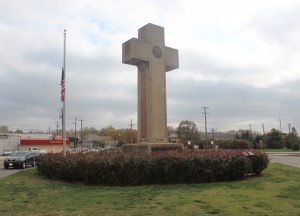The Framers Weren’t Cross Enthusiasts
 The 40-feet high "Peace Cross" in Bladensburg, MD.
The 40-feet high "Peace Cross" in Bladensburg, MD. When conservatives discuss legal philosophy, they like to talk history. Under the banner of originalism—the approach to legal analysis that interprets the US Constitution as it was understood at the time of drafting—conservatives see the mindset of the framers as paramount. With history as their guide, originalist jurists try to discern the intent of the framers and rule accordingly, with little concern for the fact that the dynamics of today’s society would have been unimaginable to the eighteenth-century men who drafted the Constitution.
I’ve commented previously on originalist jurisprudence as embodied by the godfather of originalism, the late Justice Antonin Scalia, so I won’t go down that road again here. Suffice it to say that originalism, as practiced nowadays, is more often an agenda-driven means to an end. That is, when past events contradict a desired outcome for conservatives, suddenly history is no longer their valued guide.
A case in point is the legal dispute over a forty-foot concrete Christian cross on public land in the middle of a busy traffic circle in Bladensburg, Maryland. After the American Humanist Association successfully challenged the cross in the Fourth Circuit court of appeals, the Maryland commission that owns the structure (along with the American Legion, which had intervened in the case) asked the Supreme Court to review the case. The Supreme Court granted review, and will hear the case this winter.
If the justices consider the true history of crosses as public memorials, they should uphold the Fourth Circuit’s ruling.
Because the cross was erected in the 1920s as a memorial to fallen soldiers of the First World War, its defenders claim that it passes constitutional muster. In making this argument they prefer to avoid the primary legal test for analyzing Establishment Clause violations—the Lemon Test (named after the 1971 Lemon v Kurtzman case), which considers, among other things, whether a government action has the primary effect of advancing religion. Of course a huge Christian cross advances Christianity, so there’s no way it could pass that test. Instead, cross defenders would prefer to argue history—the age of the cross, the fallen soldiers, honoring the dead, etc.
If so, humanists and others concerned about church-state separation should say one thing: bring it on! The true history of crosses in America reveals that the government has rarely utilized them, particularly as war memorials. In fact, the framers never did.
As pointed out by Dr. Kurt Piehler, a historian from Florida State University and an expert on the history of war memorials, this country has no tradition of using crosses to honor its war dead. Of the thousands of war memorials scattered across the nation, few utilize crosses and even fewer can be described as a freestanding cross like Bladensburg’s. “The use of the Cross in war memorials . . . has never been generally accepted,” he writes in an expert opinion for the court in the Bladensburg case.
There’s a good reason for excluding the Christian cross from public war memorials, Piehler explains: “The absence of Crosses on war memorials mirrors the sensitivity displayed by the American military respecting religious pluralism and diversity.”
In other words, many fallen soldiers are not Christians, so no government memorial should use a Christian symbol as a means of honoring war dead.
The Christian cross, after all, is the preeminent symbol of Christianity, both to Christians and non-Christians alike. As Piehler points out, “Some non-Christians even view the Cross as hostile to their belief.” Thus, the cross simply can’t be used as a universal symbol for war dead. Indeed, even many Christians would object to such a practice.
One interesting tidbit from Piehler’s report (which can be read in its entirety here) is that many Protestants did not consider the cross to be a legitimate symbol of Christianity until the late nineteenth century. Protestants apparently often interpreted the cross as a symbol of Roman Catholicism, and thus avoided use of it themselves. As one who has explored many old New England graveyards, I can appreciate that this information explains why colonial-era headstones almost never display a cross. Catholics were a rarity in colonial New England (“as rare as a comet or earthquake,” John Adams once gladly remarked), and therefore so were crosses.
Whether the Supreme Court uses the traditional Lemon Test or a more historical approach, a forty-foot Christian cross on public property should have little chance of surviving a constitutional challenge. Under Lemon, it obviously advances Christianity, and historically it reflects no valid tradition. For the sake of Jefferson’s wall of separation, we hope the Supreme Court agrees.
